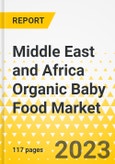This report comes with 10% free customization, enabling you to add data that meets your specific business needs.
The growing emphasis on health and wellness, coupled with rising disposable incomes in the region, has contributed to the increased demand for premium and organic baby food products. Parents are seeking transparent and clean-label options that provide nutritional benefits without compromising on the safety of ingredients. As a result, manufacturers in the Middle East and Africa are responding to this trend by offering a diverse range of organic baby food products.
Government initiatives and regulations promoting organic farming and sustainable practices also play a role in propelling the organic baby food market forward. Increased awareness and support from regulatory bodies contribute to a favorable environment for the growth of organic agriculture and subsequently, the organic baby food sector. As the Middle East and Africa witness demographic shifts, lifestyle changes, and a greater emphasis on health-conscious choices, the organic baby food market is poised for continued expansion, offering a promising landscape for companies to cater to the evolving needs of health-conscious parents in the region.
Market Segmentation:
Segmentation 1: by Distribution Channel
- Supermarkets and Hypermarkets
- Convenience Stores
- Online Retail
- Specialty stores
- Others
Segmentation 2: by Type
- Infant milk formula
- Prepared baby food
- Dried baby food
- Others
Segmentation 3: by Country
- South Africa
- Saudi Arabia
- Egypt
- UAE
- Nigeria
- Rest of Middle East and Africa
Key Market Players and Competition Synopsis
The companies that are profiled have been selected based on inputs gathered from primary experts and analysing company coverage, product portfolio, and market penetration.Some of the prominent names established in this market are:
- Amara Organic Foods
- Arla Foods amba
- Campbell Soup Company
- Nestle
- The Baby Food Company
Key Questions Answered:
- What are the main factors driving the demand for Middle East and Africa organic baby food market?
- What are the major patents filed by the companies active in the Middle East and Africa organic baby food market?
- What are the strategies adopted by the key companies to gain a competitive edge in Middle East and Africa organic baby food industry? What is the futuristic outlook for the Middle East and Africa organic baby food in terms of growth potential?
- Which type, and distribution channel is expected to lead the market over the forecast period (2023-2033)?
- What is the comparison between organic baby food and non-organic baby food?
- Which country is expected to lead the market over the forecast period (2033-2033)?
This product will be delivered within 3-5 business days.
Table of Contents
Executive Summary
The Middle East and Africa organic baby food market is set to witness significant growth, reveals the premium market intelligence study.Anticipated in the upcoming years, the organic baby food market in the Middle East and Africa (MEA) is poised for remarkable expansion. This surge is propelled by a convergence of factors, such as the heightened health consciousness among parents, escalating demands for convenience, and a rising disposable income.
Key Highlights of the Report:
Market Overview:
- Analysis of the current market size and growth potential.
- Identification of key market drivers, challenges, and opportunities.
Segmentation and Market Share:
- Detailed segmentation based on distribution channel and type.
- Insights into the market share of major players and emerging trends.
Competitive Landscape:
- Profiling of major players in the Middle East and Africa Organic Baby Food Market.
- Analysis of competitive strategies, partnerships, and mergers and acquisitions.
Forecast and Outlook:
- Projection of market trends and growth prospects for the next ten years.
- Insights into potential disruptions and factors influencing market dynamics.
Analyst Perspective
According to the Principal Analyst, 'The MEA region's organic baby food market is in its nascent phase, yet it holds substantial growth opportunities. Growing awareness of the advantages of organic goods and a rise in disposable income are anticipated to drive a sustained increase in demand for these products in the foreseeable future. Companies capable of addressing the unique requirements of parents in the region and providing innovative and convenient solutions are poised to tap into this profitable market.'Key Questions Answered in this Report:
- What are the main factors driving the demand for Middle East and Africa organic baby food market?
- What are the major patents filed by the companies active in the Middle East and Africa organic baby food market?
- What are the strategies adopted by the key companies to gain a competitive edge in Middle East and Africa organic baby food industry? What is the futuristic outlook for the Middle East and Africa organic baby food in terms of growth potential?
- Which type, and distribution channel is expected to lead the market over the forecast period (2023-2033)?
- What is the comparison between organic baby food and non-organic baby food?
- Which country is expected to lead the market over the forecast period (2033-2033)?
Companies Mentioned
- Abbott
- Almarai
- Amara Organic Foods
- Arla Foods amba
- Bumbles
- Campbell Soup Company
- Danone
- Hero Group
- Hipp
- Le Lionceau
- Nestle
- Plum, PBC.
- Ordesa
- Saipro Biotech Private Limited
- The Baby Food Company








